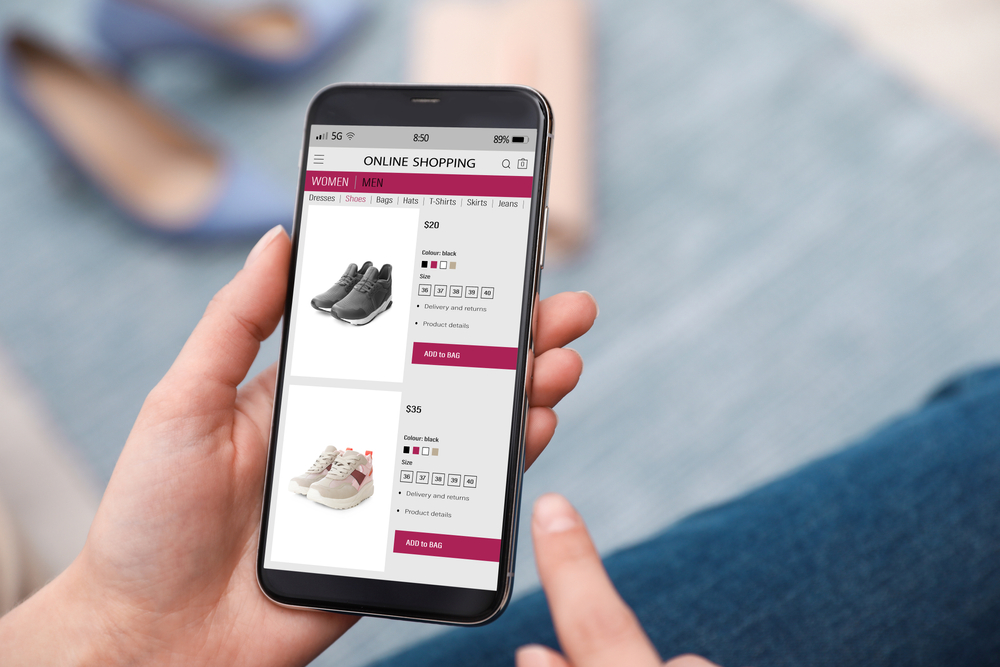Mobile device usage continues to increase year over year. This increased device utilisation combined with the pandemic-driven ecommerce boom has put mobile shopping front-and-centre for brands around the world.
With both apps and brand mobile commerce on the rise and high customer demand for a seamless omnichannel experience, brands must ensure that their mobile experiences meet and exceed shoppers’ expectations. Doing so improves not only revenue, but loyalty and customer lifetime value.
Mobile Shopping is the Future
According to Insider Intelligence and eMarketer mobile commerce is set to increase market share over the long term.
- Sales in 2021 were up 15% over 2020 and hit $359.32 billion.
- By 2025, sales are expected to reach $728.28 billion.
- Smartphones are the device of choice for mobile commerce with $553.28 billion in sales completed via smartphone through 2024.
And Statista estimates that 183.2 million shoppers in the United States will make at least one purchase on mobile in 2023 – nearly 10 million more than in 2021.
New Customer Expectations
Covid lockdowns and restrictions introduced consumers to a number of new ways to shop for, buy and collect items. Shoppers quickly made the pivot from in-store shopping to online ordering. They eschewed physical cash for contactless payments. Without complaint, they adopted curbside pickup.
While consumers have largely returned to their pre-pandemic habits, many conveniences are here to stay. These conveniences mainly fall under the omnichannel umbrella. From payments to delivery and returns, consumers are used to flexibility, and expect to have a seamless brand experience in real life and online. For example a shopper may find a product on YouTube, buy the product on a mobile commerce platform, pay with ApplePay and collect the item in-store.
“…consumers desire convenience while brands and retailers focus on purchase conversion,” Zarina Lam Stanford, CMO at Bazarrvoice recently told Forbes. “Omnichannel offerings are key as they allow a consumer to shop wherever they please, which includes things like BOPIS (buy online, pick up in-store) and curbside pickup.”
And nothing is more convenient or ubiquitous than a mobile device.
Meeting Expectations on Mobile

While mobile devices are convenient because consumers are almost always in proximity to their devices, convenience involves more than just being at a shopper’s fingertips. The means of mobile shopping (the device) is convenient, but successful brands must make sure that the end-to-end experience is as easy as picking up a smartphone.
Optimising digital properties is an ongoing process and, for many brands, involves optimising the desktop experience first. But given the increased popularity of mobile commerce, winning brands selling DTC cannot afford to de-prioritise mobile. To begin mobile optimisation, brands must know what shoppers expect.
- A single account login on desktop and mobile
- Order status tracking across devices
- Simple, transparent returns policy
- Flexible shipping and pick-up options
- Returns tracking across devices
Adding another layer of complexity is the increase in international shopping. Global brands selling direct-to-consumer cannot optimise only their domestic properties, but they must take into account the experience and expectations of customers in each market. In general, shoppers want and expect a local experience even if they buy from a brand located on the other side of the world.
- Website copy is in the local language
- Transparent pricing, including duties, taxes and fees
- Prices displayed in local currency
- Local and multiple payment options, not just major credit cards
- Customer service provided in native language
- Clear, understandable returns and refund policies
- Ability to track shipment across devices
Shoppers expect a frictionless shopping experience across devices and channels.
Mobile-First Best Practices
Brands selling DTC that want to meet and exceed shopper expectations must adopt a mobile-first strategy. Mobile-first design means that websites are designed for smaller screens. Tablets and smartphones do not have the screen space to comfortably accommodate all the same elements as a desktop or laptop. When screens are cluttered, buttons are too close together or form fills are too small, shoppers are more likely to abandon a site.
Taking into account less screen real estate on cell phones and tablets, UX designers take specific steps to optimise ecommerce sites for mobile.
Improve Readability
Brands should not force mobile shoppers to read small, compact print. Shoppers will grow frustrated if they have to zoom in and out on their phone screens to read the navigation menu, product description or form field labels. Brand can enhance the mobile shopping experience and reduce cart abandonment by keeping copy concise, increasing the font size and mimising page clutter.
Include Autofill
Form fills are necessary on every device but are particularly frustrating on mobile. Typically the fields are small and require the shopper to tap in multiple places and open and close their keypad. Brand should include autofill to reduce the number of manual entries a customer has to make to complete a transaction. In addition, including drop-down field options can reduce mobile shopping friction.
Increase Button Size
Similar to resizing copy, increasing button size lets mobile shoppers more easily complete purchases. Tapping is inherently less precise than clicking with a mouse, so brands should make it easy for customers to complete tasks like adding to cart and confirming the purchase.
Improve Site Speed
Mobile shopping is often done on the go where there may or may not be adequate data speed. A page that takes milliseconds to load on a laptop connected to high-speed internet at home may not perform the same on public transportation or in a waiting room. Brands can reduce image weight and optimise coding to ensure that the most important page elements load first and that site speed is consistent across devices.
Integrate Digital Wallets
Brands should include tappable payment options so mobile shoppers do not have to tap in their credit card information. Reducing manual payment entry by offering BNPL, PayPal or GooglePay reduces checkout friction and frustration, and boosts conversion rates.
The Takeaway
Mobile shopping is here to stay. Brands that prioritise mobile optimisation will win out over brands that do not. But in addition to optimising, brands must localise content as well and provide a domestic-equivalent experience to global shoppers.
ESW enables market expansion and ensures that our customers can provide the best experience for their customers. From robust, sophisticated payments, omnichannel and logistics to end-to-end platform design and operations, our solutions help the world’s best-loved brands reach global customers. Contact us today.





